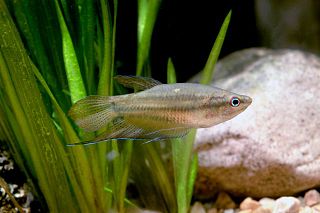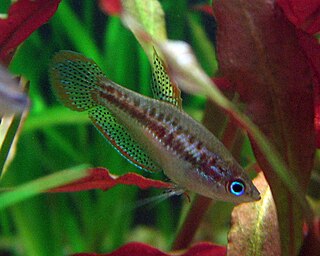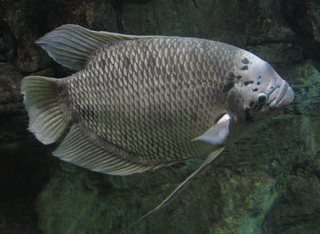
Gouramis, or gouramies, are a group of freshwater anabantiform fish that comprise the family Osphronemidae. The fish are native to Asia—from the Indian Subcontinent to Southeast Asia and northeasterly towards Korea. The name "gourami", of Indonesian origin, is also used for fish of the families Helostomatidae and Anabantidae.

The dwarf gourami is a species of gourami native to South Asia.

The pearl gourami is a species of gourami native to Southeast Asia.

The croaking gourami is a species of small freshwater labyrinth fish of the gourami family. They are native to still waters in Southeast Asia and are distributed worldwide via the aquarium trade. Croaking gouramis are capable of producing a "croaking" noise using their pectoral fins.

Trichogaster is a genus of gouramis native to South Asia from Pakistan to Myanmar. It is the only genus in the monotypic subfamily Trichogastrinae as set out in the 5th Edition of Fishes of the World, although that book states that there are two genera, the other being Colisa which is treated as a synonym of Trichogaster by Fishbase and the Catalog of Fishes. Fishbase also places the genus in the Luciocephalinae. Species of this genus are very popular in the aquarium trade.

The Anabantoidei are a suborder of anabantiform ray-finned freshwater fish distinguished by their possession of a lung-like labyrinth organ, which enables them to breathe air. The fish in the Anabantoidei suborder are known as anabantoids or labyrinth fish, or colloquially as gouramies. Some labyrinth fish are important food fish, and many others, such as the Siamese fighting fish and paradise fish, are popular as aquarium fish.

The thick-lipped gourami is a species of gourami native to Southeast Asia, and is a popular aquarium fish.

Osphronemus is a genus of large gouramis, the only genus within the subfamily Osphroneminae. These fish are known as the giant gouramis and are native to rivers, lakes, pools, swamps and floodplains in Southeast Asia, with O. exodon from the Mekong basin, O. laticlavius and O. septemfasciatus from Borneo, while O. goramy is relatively widespread. O. goramy has been introduced outside its native range in Asia, Africa and Australia.

The moonlight gourami, also known as the moonbeam gourami, is a labyrinth fish of the family Osphronemidae native to Indochina. This peaceful species is a popular aquarium fish.

The snakeskin gourami is a species of gourami native to Southeast Asia. Prior to the merging of Belontidae to the family Osphronemidae, the snakeskin gourami was regarded as the largest member of its family. It is still the largest species in its genus and subfamily.

Trichopodus is a genus of tropical freshwater labyrinth fish of the gourami family found in Southeast Asia. Gouramis of the genus Trichopodus are closely related to those of Trichogaster ; species of both genera have long, thread-like pelvic fins used to sense the environment. However, Trichopodus species have shorter dorsal fin base and, when sexually mature, are much larger, with the largest, the snakeskin gourami, capable of reaching a length of over 8 in (20 cm).

The ornate paradisefish or spotted gourami, is a species of gourami endemic to Sri Lanka. It is the only recognized species in its genus.

Parosphromenus is a genus of gouramies native to freshwater in Southeast Asia. All species are highly specialized peat swamp inhabitants native to southeast Asia, and the males are usually brightly colored in breeding dress; however, their need for soft, acidic water and live food prohibits the genus from becoming popular aquarium fish.

Trichopsis is a genus of gouramies native to Southeast Asia.

The Malay combtail is a species of gourami native to southeast Asia where it is found in peat swamps of the Malay Peninsula and the Greater Sunda Islands. This species can reach a length of 20 centimetres (7.9 in) SL. It is a commercially important species and is also found in the aquarium trade. This species was formally described by Georges Cuvier in 1831 with the type locality of Java. The collector of the type was collected in 1820 by the Dutch physician and biologist Johan Coenraad van Hasselt (1797-1823), whom Cuvier honoured in its specific name, with his friend Heinrich Kuhl.
The frail gourami or noble gourami is a mouth brooding species of gourami native to northeastern India and Bangladesh. This species grows to a length of 10 cm (3.9 in). It is only seldom found in the aquarium trade, courtesy of its extreme sensitivity to shipping stress and high levels of aggression. This species is the only known member of its genus.

Sphaerichthys is a genus of gouramis native to Southeast Asia known as chocolate gourami. These species live mostly in blackwater rivers/swamps with acidic water. They have dark-light brownish hues with the exception being the female of S. vaillanti which can be dark reddish brown with green-dark blue/black stripes. They are shy fish that are hard to find because of their camouflage which when in action makes them look like a dead leaf floating along the river.

Trichogaster fasciata, the banded gourami or striped gourami or Colisa or Kholshe, is a tropical labyrinth perch found in some Asian countries like Bangladesh, Eastern India, Northeastern India, Nepal, Upper Myanmar, China and Pakistan.

The giant gourami is a species of large gourami native to freshwater habitats in Southeast Asia. It has also been introduced elsewhere. The species is commercially important as a food fish and is also farmed. It can be found in the aquarium trade, as well. The species has been used for weed control on highly invasive aquatic plants like Salvinia molesta, as the giant gourami can be a voracious herbivore.

The Anabantiformes, collectively known as labyrinth fish, are an order of air-breathing freshwater ray-finned fish with two suborders, five families and having at least 207 species. In addition, some authorities expand the order to include the suborder Nandoidei, which includes three families - the Nandidae, Badidae and Pristolepididae - that appear to be closely related to the Anabantiformes. The order, and these three related families, are part of a monophyletic clade which is a sister clade to the Ovalentaria, the other orders in the clade being Synbranchiformes, Carangiformes, Istiophoriformes and Pleuronectiformes. This clade is sometimes referred to as the Carangaria but is left unnamed and unranked in Fishes of the World. This group of fish are found in Asia and Africa, with some species introduced in United States of America.

















